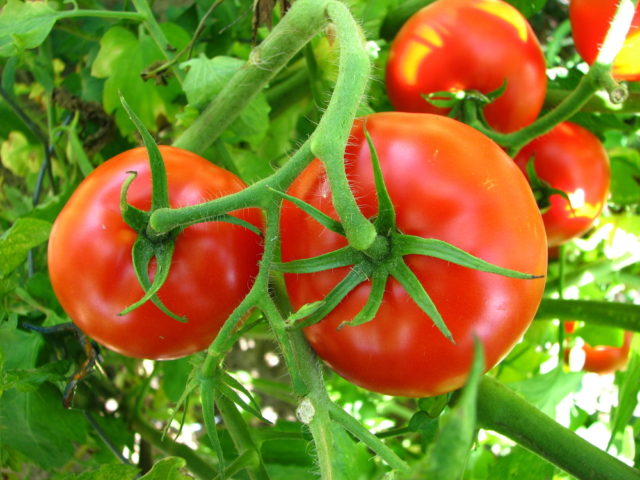How do we plant a tomato, you might ask? With a ridiculous amount of stuff in the hole, is the answer. When someone ropes me into telling them and I start the long answer, I eventually see their eyes glaze over. That’s the point where I say, “Then you throw in the kitchen sink and cover it all up.” To date, no one has laughed at that joke.
 I think they’re just either too overwhelmed by the real stuff we put in there, or they actually believe we’re throwing in a sink.
I think they’re just either too overwhelmed by the real stuff we put in there, or they actually believe we’re throwing in a sink.
This is how we plant a tomato. First off, let’s take a look at our sexy specimen here on the left.
We started this beauty in our heated greenhouse in late January. We potted it up to a gallon container about 3 or 4 weeks ago. It will go into one of our freshly prepared beds, shown to the right. 
The tomatoes are placed three feet apart. I’ve learned over the years that spacing them closer than that means less fruit. We dig a nice deep hole to accommodate all the additions – the exact depth is dependent upon how tall the seedling is that you start with. We want the plant to be almost completely submerged into the soil, and the fish head and amendments put into the hole need to be covered with a bit of soil, so we plan accordingly for the depth. This particular hole ends up being almost two feet deep, and is ready for our first goody, these impressive fish heads. We get them from the restaurant we grow for, Manresa. You might be able to get them free from a good butcher or fishmonger. I even know of someone who called a few restaurants in their area and was quickly rewarded with a nice bounty of juicy fish heads.
We get them from the restaurant we grow for, Manresa. You might be able to get them free from a good butcher or fishmonger. I even know of someone who called a few restaurants in their area and was quickly rewarded with a nice bounty of juicy fish heads.
Fish tails, spines, guts, as well as shrimp, crab, or lobster shells are all good as well. Some of you may worry about critters digging these up later. We’ve never had a problem with animals digging up my tomatoes, and we’ve got three dogs, two cats, and what seem like an endless supply of raccoons living on the property. I stress the point that this is the first thing that goes into our very deep planting hole. That may help keep it from getting dug up. You can see the six inch long fish head staring up at us from the bottom of the hole here:
If you’re reticent to put the fish head in the hole, or simply can’t get your mitts on any, we recommend using fish meal as a substitute. Two handfuls is about right. We get ours from Gardner & Bloome.
The next thing that goes into the hole are a couple of aspirin tablets and some crushed chicken egg shells.  The aspirin is to help jump start the plant’s immune system. You can read more about that science here. We’ll put three or four crushed egg shells into the hole as well. You can see our three colors of eggs from our fancy chickens – yes, those are green eggs in there. The eggs supply a nice calcium boost, which will help prevent blossom end rot, that nasty brown patch on the bottom of tomatoes that lack calcium (the fish head bones and bone meal also help with that).
The aspirin is to help jump start the plant’s immune system. You can read more about that science here. We’ll put three or four crushed egg shells into the hole as well. You can see our three colors of eggs from our fancy chickens – yes, those are green eggs in there. The eggs supply a nice calcium boost, which will help prevent blossom end rot, that nasty brown patch on the bottom of tomatoes that lack calcium (the fish head bones and bone meal also help with that).
 Bone meal is the next to go into the hole. We put in a heaping handful of bone meal. This is a nice organic phosphorus source, which is essential for blossom production. More blossoms, more fruit. Bone meal also increases calcium availability for the tomato. This is also a Gardner & Bloome product.
Bone meal is the next to go into the hole. We put in a heaping handful of bone meal. This is a nice organic phosphorus source, which is essential for blossom production. More blossoms, more fruit. Bone meal also increases calcium availability for the tomato. This is also a Gardner & Bloome product.
We then put in two handfuls of Gardner & Bloome’s Tomato, Vegetable and Herb Fertilizer. It’s an all-purpose organic fertilizer that contains the essential macronutrients of nitrogen, phosphorus and potassiun. Their mix is a very nice 4-6-3 of those nutrients.
We also recommend putting a handful of pure worm castings in the bottom of the hole. We amend our beds with worm castings and we also spray a worm casting tea on the plants while they grow. Really great stuff. Worm castings are available for sale at our tomato plant sale.
 The hole is complete (sans kitchen sink) and we’re now ready to pop in the tomato plant. We trim off the lower leaves, be there one, two, three or more, leaving only the top-most leaves.
The hole is complete (sans kitchen sink) and we’re now ready to pop in the tomato plant. We trim off the lower leaves, be there one, two, three or more, leaving only the top-most leaves.
We put an inch or two of soil on top of the amendments in the hole. The plant is eased out of the pot, and before it’s placed in the hole, I sprinkle a third of a cup or more on the rootball with a product called Xtreme Gardening’s Mykos, which is a mycorrhizal fungi that attaches to the roots, growing as the root ball grows. It protects the plant from some diseases, such as verticillium and fusarium wilts. If there are any “silver bullets” here, it is this healthy addition of mycorrhizal fungi.
Once the tomato is in the hole, we double check the depth by judging how far out of the ground the plant will be sticking.  If it’s going to be too far down, we’ll remove the plant and add some more soil. If it looks like it’ll be up above the soil more than we want, that’s too bad because we ain’t gonna be fishing them fish parts and all that other stuff up out of that hole and digging it deeper. No siree. So we try our best to gauge the depth of the hole according to the height of the plant we’re putting in.
If it’s going to be too far down, we’ll remove the plant and add some more soil. If it looks like it’ll be up above the soil more than we want, that’s too bad because we ain’t gonna be fishing them fish parts and all that other stuff up out of that hole and digging it deeper. No siree. So we try our best to gauge the depth of the hole according to the height of the plant we’re putting in.
We then back fill GENTLY – only one quasi-firm push settles the soil around the plant.  Please do not man-handle the soil around the plant by stomping on it or pressing too hard. That’s not necessary and it expels all the air out of the soil. Believe it or not, the roots need oxygen down there just as much as they need nutrients and water.
Please do not man-handle the soil around the plant by stomping on it or pressing too hard. That’s not necessary and it expels all the air out of the soil. Believe it or not, the roots need oxygen down there just as much as they need nutrients and water.
A temporary well is then made around the plant base to catch the first watering.  The first watering is the most critical. We do it multiple times. Water it in once, twice, three times at least. Wait a few minutes to allow the water to drain through. If you have a deep hole, likely way more than 12 inches deep, you will be amazed at how much water it will take to wet the root ball a foot or more under the ground. So don’t be stingy with the water the first day. Thereafter, you can back off the watering. Here’s our finished bed. You can see the tomatoes are spaced pretty far apart:
The first watering is the most critical. We do it multiple times. Water it in once, twice, three times at least. Wait a few minutes to allow the water to drain through. If you have a deep hole, likely way more than 12 inches deep, you will be amazed at how much water it will take to wet the root ball a foot or more under the ground. So don’t be stingy with the water the first day. Thereafter, you can back off the watering. Here’s our finished bed. You can see the tomatoes are spaced pretty far apart:
Drip irrigation will be repositioned on the bed, and staking and mulching has yet to be done. In the meantime, please feel free to email us or leave a comment below with any questions.
If you’re still not getting the results you want, then consider taking our Tomato Masters class.
You can find more information all about tomatoes on the World Tomato Society website.
Good luck, folks!
Source: Grow Better Veggies







